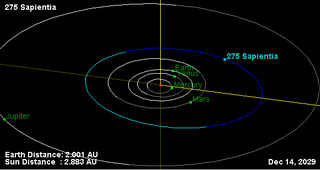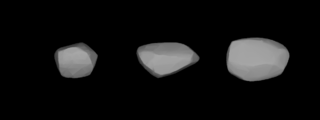Related Research Articles

Maria is a Main belt asteroid that was discovered by French astronomer Henri Joseph Perrotin on January 10, 1877. Its orbit was computed by Antonio Abetti, and the asteroid was named after his sister, Maria. This is the namesake of the Maria asteroid family; one of the first asteroid families to be identified by Japanese astronomer Kiyotsugu Hirayama in 1918.

Iduna is a large main-belt asteroid that was discovered by German-American astronomer Christian Heinrich Friedrich Peters on October 14, 1877, in Clinton, New York. It is named after Sällskapet Idun, a club in Stockholm that hosted an astronomical conference; Idun is also a Norse goddess. A G-type asteroid, it has a composition similar to that of the largest main-belt asteroid, 1 Ceres.

Ambrosia is a main belt asteroid that was discovered by the Corsican-born French astronomer J. Coggia on February 28, 1879, and named after Ambrosia, the food of the gods in Greek mythology.

Atropos is a typical Main belt asteroid that was discovered by Austrian astronomer Johann Palisa on 8 March 1888 in Vienna.

Sapientia is a very large Main belt asteroid that was discovered by Johann Palisa on 15 April 1888 in Vienna. It is classified as a C-type asteroid and is probably composed of carbonaceous material. It is named for the Roman personification of wisdom, Sapientia.
Cheruskia is a minor planet, specifically an asteroid orbiting in the asteroid belt that was discovered by German astronomer Paul Götz on 26 July 1905 from Heidelberg.

Recha is a minor planet, specifically an asteroid orbiting in the asteroid belt between Mars and Jupiter. The asteroid, discovered by German astronomer Max Wolf on September 19, 1905, was named after a character in Gotthold Ephraim Lessing's play Nathan the Wise and may have been inspired by the asteroid's provisional designation 1905 RC.
Renate is a minor planet, specifically an asteroid orbiting in the asteroid belt which was discovered by German astronomer Max Wolf on September 19, 1905. The name may have been inspired by the asteroid's provisional designation 1905 RE.

Rebekka is a minor planet orbiting the Sun, which was discovered on September 19, 1905, by a German astronomer Paul Götz in Heidelberg. It was named after a young lady from Heidelberg, and may have been inspired by the asteroid's provisional designation 1905 RB.
Bilkis is a minor planet, specifically an asteroid orbiting in the asteroid belt. It was discovered by German astronomer August Kopff in 1906 February and was given the Koran name for the Queen of Sheba. Photometric observations at the Palmer Divide Observatory in Colorado Springs, Colorado in 2006–7 were used to build a light curve for this object. The asteroid displayed a rotation period of 8.5742 ± 0.0005 hours and a brightness variation of 0.40 ± 0.02 in magnitude.

Juvisia is a minor planet, specifically an asteroid orbiting in the asteroid belt that was discovered 27 August 1906 in Heidelberg by German astronomer Max Wolf. It was named after the commune Juvisy-sur-Orge, France, where French astronomer Camille Flammarion had his observatory.
607 Jenny is a minor planet, specifically an asteroid orbiting in the asteroid belt that was discovered by German astronomer August Kopff on September 18, 1906.
620 Drakonia is a minor planet, specifically an asteroid orbiting in the asteroid belt. It was discovered October 26, 1906, in Taunton, Massachusetts, by American astronomer Joel Hastings Metcalf and given the preliminary designation 1906 WE. It may have been named for Drake University.
660 Crescentia is a minor planet orbiting the Sun that was discovered by American astronomer Joel Hastings Metcalf on January 8, 1908. The name may have been inspired by the asteroid's provisional designation 1908 CC. Peter Ting points out that the Rev. Joel Metcalf of Taunton (Massachusetts) discovered six asteroids with unexplained names, though listed in Lutz Schmadel's book. Ting used an on-line planetarium website to help with the location of some of the planets, playing back to the night of discovery. He noticed that there was a crescent moon (33%) low in the western sky and wonders if the Rev. Metcalf could have named the asteroid for the Moon. Crescentia would be a very unusual name for a person but not for a phase of the Moon.
687 Tinette is a minor planet, specifically an asteroid orbiting primarily in the asteroid belt. It was discovered by Austrian astronomer Johann Palisa on 16 August 1909 from Vienna and was given the preliminary designation 1909 HG.

708 Raphaela is a minor planet orbiting the Sun.

747 Winchester is an asteroid, a minor planet orbiting the Sun. It was discovered in 1913, and is named after the town in which it was discovered, Winchester, Massachusetts, in the USA.
793 Arizona is a minor planet orbiting the Sun that was discovered April 9, 1907 by American businessman Percival Lowell at Flagstaff. It was named for the state of Arizona. The object was independently discovered on April 17, 1907, by J. H. Metcalf at Taunton. This is a main belt asteroid orbiting 2.8 AU from the Sun with a period of 4.675 yr and an eccentricity (ovalness) of 0.13. The orbital plane is inclined at an angle of 15.8° to the plane of the ecliptic.
840 Zenobia is a minor planet orbiting the Sun. It was discovered by German astronomer Max Wolf at Heidelberg on September 25, 1916. The origin of the name is uncertain, but it may be named after the Slavic god of the hunt.
947 Monterosa is a minor planet orbiting the Sun.
References
- ↑ Noah Webster (1884) A Practical Dictionary of the English Language
- ↑ Yeomans, Donald K., "639 Latona", JPL Small-Body Database Browser, NASA Jet Propulsion Laboratory, archived from the original on 17 August 2014, retrieved 5 May 2016.
- ↑ Warner, Brian D. (June 2008), "Asteroid Lightcurve Analysis at the Palmer Divide Observatory - June - October 2007", The Minor Planet Bulletin, 35 (2): 56–60, Bibcode:2008MPBu...35...56W.
- ↑ Veeder, G. J.; et al. (March 1995), "Eos, Koronis, and Maria family asteroids: Infrared (JHK) photometry" (PDF), Icarus, 114 (1): 186–196, Bibcode:1995Icar..114..186V, CiteSeerX 10.1.1.31.2739 , doi:10.1006/icar.1995.1053.